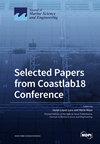Development and Application of an Advanced Automatic Identification System (AIS)-Based Ship Trajectory Extraction Framework for Maritime Traffic Analysis
IF 2.8
3区 地球科学
Q1 ENGINEERING, MARINE
引用次数: 0
Abstract
This study addresses the challenges of maritime traffic management in the western waters of Taiwan, a region characterized by substantial commercial shipping activity and ongoing environmental development. Using 2023 Automatic Identification System (AIS) data, this study develops a robust feature extraction framework involving data cleaning, anomaly trajectory point detection, trajectory compression, and advanced processing techniques. Dynamic Time Warping (DTW) and the Hierarchical Density-Based Spatial Clustering of Applications with Noise (HDBSCAN) algorithms are applied to cluster the trajectory data, revealing 16 distinct maritime traffic patterns, key navigation routes, and intersections. The findings provide fresh perspectives on analyzing maritime traffic, identifying high-risk areas, and informing safety and spatial planning. In practical applications, the results help navigators optimize route planning, improve resource allocation for maritime authorities, and inform the development of infrastructure and navigational aids. Furthermore, these outcomes are essential for detecting abnormal ship behavior, and they highlight the potential of route extraction in maritime surveillance.开发和应用基于先进自动识别系统 (AIS) 的船舶轨迹提取框架,用于海上交通分析
台湾西部水域商业航运活动频繁,环境开发持续进行,本研究旨在应对该地区海上交通管理的挑战。本研究利用 2023 年的自动识别系统(AIS)数据,开发了一个强大的特征提取框架,包括数据清理、异常轨迹点检测、轨迹压缩和高级处理技术。应用动态时间扭曲(DTW)和基于层次密度的带噪声应用空间聚类(HDBSCAN)算法对轨迹数据进行聚类,揭示了 16 种不同的海上交通模式、主要航行路线和交叉路口。这些发现为分析海上交通、识别高风险区域以及为安全和空间规划提供信息提供了新的视角。在实际应用中,这些成果有助于导航员优化航线规划,改善海事机构的资源分配,并为基础设施和导航辅助设备的开发提供信息。此外,这些成果对于检测异常船舶行为至关重要,并凸显了航线提取在海事监控中的潜力。
本文章由计算机程序翻译,如有差异,请以英文原文为准。
求助全文
约1分钟内获得全文
求助全文
来源期刊

Journal of Marine Science and Engineering
Engineering-Ocean Engineering
CiteScore
4.40
自引率
20.70%
发文量
1640
审稿时长
18.09 days
期刊介绍:
Journal of Marine Science and Engineering (JMSE; ISSN 2077-1312) is an international, peer-reviewed open access journal which provides an advanced forum for studies related to marine science and engineering. It publishes reviews, research papers and communications. Our aim is to encourage scientists to publish their experimental and theoretical results in as much detail as possible. There is no restriction on the length of the papers. The full experimental details must be provided so that the results can be reproduced. Electronic files and software regarding the full details of the calculation or experimental procedure, if unable to be published in a normal way, can be deposited as supplementary electronic material.
 求助内容:
求助内容: 应助结果提醒方式:
应助结果提醒方式:


